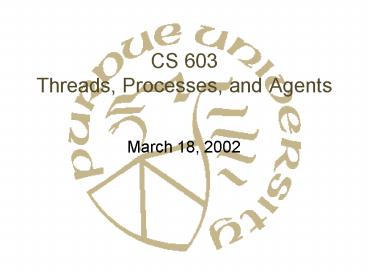CS 603 Threads, Processes, and Agents PowerPoint PPT Presentation
Title: CS 603 Threads, Processes, and Agents
1
CS 603Threads, Processes, and Agents
- March 18, 2002
2
Goal Operate at Remote Site
- Client-Server Model
- Client requests service
- Scope of available services known in advance
- Remote Procedure Call
- Call existing procedure at remote site
- Problem Remote Site must already know what we
want to do!
3
Goal Operate at Remote Site
- How is this handled in non-distributed system?
- Write and run a program!
- Are there single-system analogues to starting
arbitrary operation? - Processes
- Threads
4
Process Model
- Basic idea Virtual MachineModel complete
ownership of machine - Memory
- Files
- Processing
- How does this fit with Distributed System?
- It doesnt
- Solution Multiple Processes
- Each process on different virtual machine
- In Distributed System, different real machine
5
Multiple Processes How
- Fork Create child as clone of current process
- Wouldnt execution be same as parent?Process ID
is new, as are a few other things - Exit Terminate process
- Frees resources, closes files, etc.
- Wait Parent waits for child to terminate
- Block until child exits
- What about multiple children?
6
Inter-process Communication
- Not very interesting if processes completely
independent - Files Process can write and read same file
- Synchronization difficulties
- Pipes One-way FIFO buffer between processes
- Sounds like stream-oriented communication
- Shared Memory
- Explicitly declared shared area
- Also semaphore primitive
- This is beginning to sound like a distributed
system!
7
Remote Fork
- Why isnt Remote Fork a primitive
- Fork clones process
- Copies memory
- Same open file descriptors
- Expensive at best, infeasible at worst
- Solution Process as local proxy
- Fork creates process
- Child uses RPC/? to start remote execution
8
Threads
- Multiple activities in same address space
- Process model creates new address space
- Threads share i.e., all memory is shared
- Shared variables for communication
- Mutex mutual exclusion primitive
- Condition variable wait/signal
- Join wait for particular process
- Even more difficult in distributed system
- Requires distributed shared memory model
- Again use as local proxy to start remote code
9
So where are we?
- Models for Remote Processing
- Server Request documented service
- RPC Request execution of existing procedure
- What if operation we want isnt offered remotely?
- Solution Agents / Code Migration
10
Code Migration
- Process consists of
- Code
- Resources (files, devices, etc.)
- Execution (data, stack, registers, etc.)
- Fork copies everything
- Is this needed?
- Solution Copy part of the process
11
Types of Code Migration
- Weak mobility Copy only code
- Program starts from initial state
- Example Java applets
- Strong mobility Copy code and execution
- Resume execution where it stopped
- But doesnt necessarily have same resources (less
than fork) - Example DAgents (later), cluster computing
(Condor, LSF)
12
Types of Code Migration
- Sender Initiated
- Receiver Initiated
- Examples
- Java Applets
- Receiver Initiated
- Cluster computing
- Sender Initiated?
- Central manager initiated?
13
Types of Code Migration
- Where executed?
- In target process
- In new process
- Strong Mobility Move vs. Copy
- Migrate process Ceases at originating site
- Clone process Two copies in parallel
14
Types of Code Migration
From Andrew Tanenbaum, Distributed Operating
Systems, 1995.
15
The Hard Part Resources
- Migrated process still needs resources
- Options to Connect to a Resource (Fugetta et al.,
1998) - Binding by identifier (e.g., URL)
- Attach to the same resource
- Binding by value (e.g., standard libraries)
- Bind to equivalent resource
- Bind by type (e.g., local printer)
- Bind to resource with same function
16
The Hard Part Resources
- Alternative Move the Resource
- Unattached resources (e.g., data files)
- Relatively easy to move
- Fastened resource (e.g., database)
- Expensive to move
- Fixed resource (e.g., communications endpoint)
- Cant be moved
17
Resource Binding
18
What about Heterogeneity?
- Assumption Same code runs at both source and
target - Weak mobility Can compile/execute same source
- Strong mobility More difficult
- C/Pascal/etc. Mobile only at subroutine call
- Use same mechanisms as RPC
- Translate parameters and stack/globals
- Return goes back to original machine
- Java Hide heterogeneity in virtual machine
19
What Next?
- Specific Example DAgents
- Research Project at Dartmouth
- Basic idea Mobile agents
- Based on Tcl
- Project 3 will use DAgents
- Still working on appropriately scoped task
- Feel free to start reading
- http//agent.cs.dartmouth.edu

